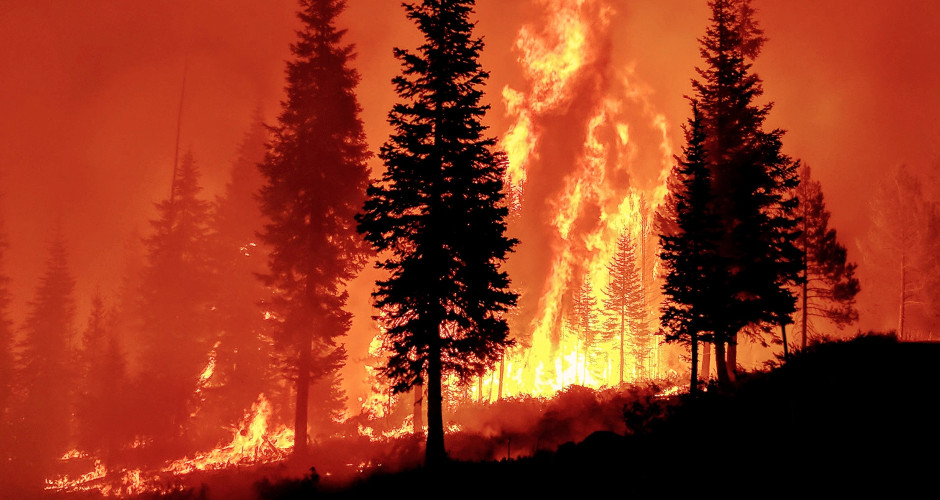— Published with Permission of FreeRangeReport.com —
…the Badger Creek Fire’s suppression costs exceed $6.3 million. That’s especially ironic when timber mills spent years trying to pay the Forest Service for the same trees that are now dead and burned. The government could have made money instead of losing money, and saved jobs, communities, watersheds, and habitat in the process.
A Pat on the Back, or a Shove?
My friend Bill Imbergamo runs a highly effective national association for what’s left of America’s forest products industry. Last week he called attention to a new glossy two-page paper from the U.S. Forest Service, claiming credit for a forest management project that helped control a fire on Wyoming’s Medicine Bow National Forest.
The agency says its thinning project created a “fuel break” that helped direct June’s “Badger Creek Fire” away from a community, and save several houses. The story is familiar – forest thinning changes the behavior of fires. As the agency’s slick publication explains, “Because of the reduction in dry, thick vegetation near the homes, firefighters… were able to safely approach the buildings and strategically place resources near the majority of the structures the day the fire began.” These catastrophic fires have destroyed over 100 million acres of national forests in the last 20 years, and often behave as this one did: “The fire moved away from one community, took off as a crown fire, and then reached the next fuels treatment area… and combined with effects of the retardant that had been applied, fire behavior quickly moderated.” In other words, the fire destroyed nearly everything in its wake until it reached the area that had been properly managed, and then slowed dramatically.
Nature maintained these forests for centuries. Periodic lightning fires burned the shrubs, brush, and smaller trees, so the forest didn’t grow too dense. Those natural fires left most of the older and larger trees alone, as we know from tree ring analyses of centuries of fires. When Americans began to depend on the forests for wood and other resources, they understandably viewed forest fires as crises. For over a century, the dominant culture of national forest management was fire suppression.
Still, the forests still did not grow overly dense because under professional management, the natural role of fire was replaced with a steady program of forest thinning. National forests were logged to provide lumber and healthy watersheds, and to prevent fires. But in the last 30 years, logging became unpopular, and the cutting of trees was all but stopped, and that management tool has been replaced with nothing at all. The result was a massive overgrowth, turning forests into tinderboxes that explode into uncontrollable fires that destroy everything, including the large old trees. These fires are not natural; they are the result of mismanagement. The Forest Service still thins only a fraction of the new growth each year, and the problem continually worsens.
Thus, it is understandable that when a thinning project does some good, the agency would want to claim credit, and use it to educate others on the need for active management. Clearly, that was the Forest Service’s objective in highlighting the Medicine Bow project and its effect on the Badger Creek Fire. Perhaps they deserve to toot their own horn in this instance. Unfortunately, there is another side of the same story, one that leaves observers wondering why the Badger Creek Fire, which is still not fully contained, destroyed over 21,000 acres before it reached a “managed” area. In fact, professional foresters saw this coming years ago and sounded the alarm, but to no avail.
Imbergamo shared a particularly poignant memory from a former timber manager and good friend of mine. “I begged the Forest Service to manage that area back in the early 2000’s and they chose not to. The area that burned now would have supplied enough wood to have run the mill I managed in Laramie for 2 years. Instead they let the bugs kill the timber, killed the mill and its employees and loggers with a lack of supply of timber.”
The Interagency Fire Center says the Badger Creek Fire’s suppression costs exceed $6.3 million. That’s especially ironic when timber mills spent years trying to pay the Forest Service for the same trees that are now dead and burned. The government could have made money instead of losing money, and saved jobs, communities, watersheds, and habitat in the process. Its failure to do so is cultural, systemic, and entrenched. For years, Forest Service leaders have talked about active management, timber industry partnerships, and the need for landscape-scale thinning. But what they have actually done is a handful of thinning projects in a few isolated areas, designed to save houses and facilities, not forests.
Perhaps this current pat on the back should be more of a shove. If careful thinning projects work so well in small areas around homes, perhaps they might also save an entire forest.


